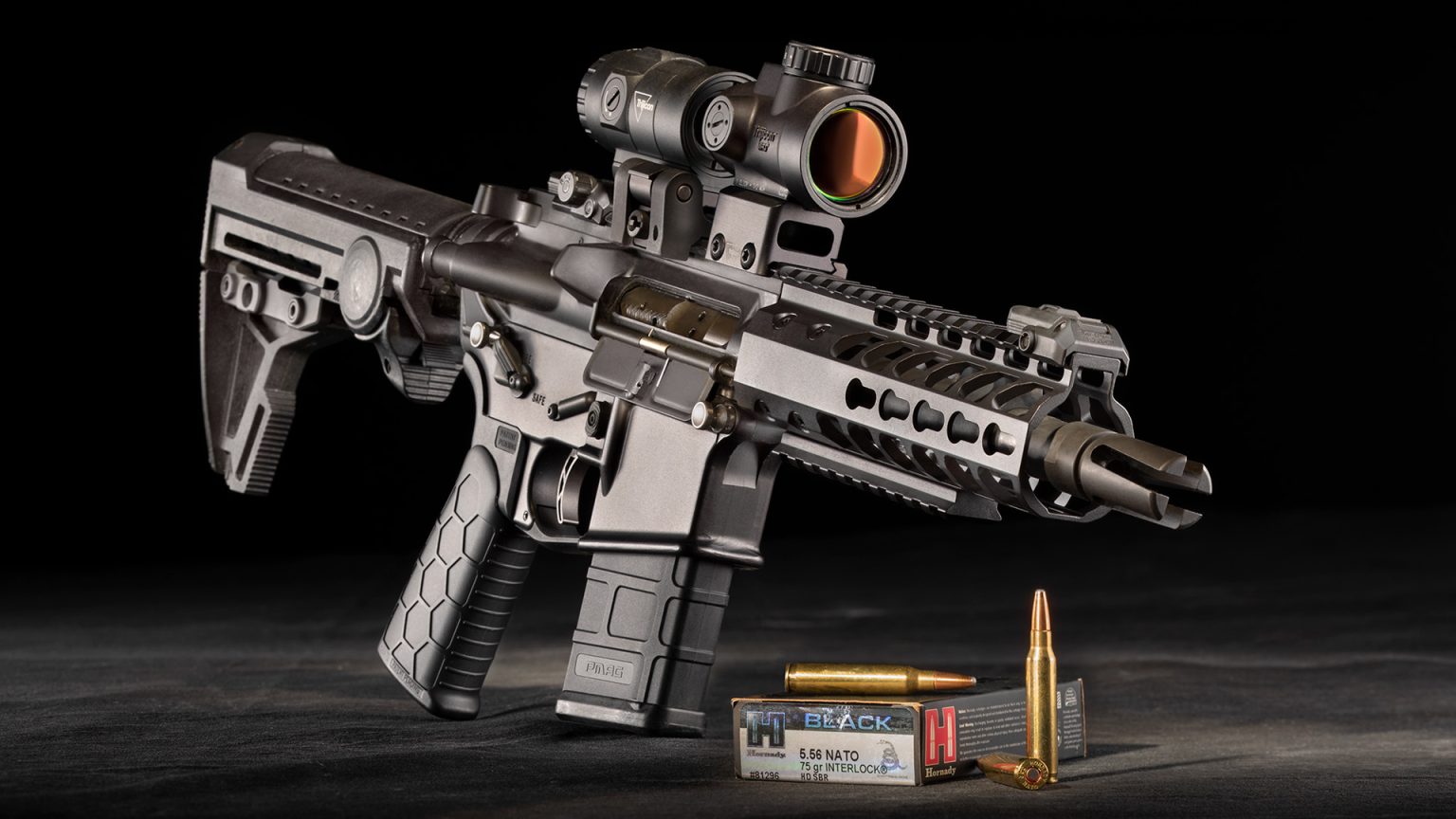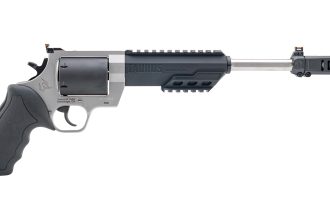Customized ammunition, like Hornady’s HD SBR Black load for 5.56 NATO-chambered SBRs, is often needed to obtain peak performance from shorter barrels.
In the course of the past couple decades, the popularity of firearms with short barrels and rifle receivers has steadily increased. So far, those who can afford it have been willing to jump through paperwork hoops and pay the additional $200 tax for already-expensive, but very handy, short-barreled rifles (SBRs). With President Trump’s One Big Beautiful Bill Act, that tax will no longer apply beginning in 2026. And, if litigation filed by NRA and other pro-gun groups succeeds, the registration and paperwork hoops will go away as well.
These aren’t the only reduced-size options available. Rifles with pinned and welded muzzle devices that extend short barrels to at least 16 inches (and overall firearm lengths to at least 26 inches) have become extremely popular as well. Large-format pistols offer many of the same advantages, albeit with caveats. Each of these options brings stiffer barrels, lighter weights and ease of storage or use in confined spaces to the party.
Unfortunately, these positives come with baggage, including harsher recoil and increases in muzzle flash and blast. The reduced performance of slower-moving, expanding projectiles is another attention-worthy short-barrel byproduct. Simply using lighter bullets or amped-up loads to boost velocities doesn’t always remedy that problem—and often creates others. Fortunately, modern technology is here to help.
Most of the major U.S. ammunition manufacturers offer .223 Rem./5.56 NATO loads and common pistol-caliber options that expand well from short barrels. Several other popular chamberings are trending toward lower-velocity performance as well. Likewise, the list of expanding loads for subsonic cartridges continues to grow.
In terms of increased muzzle flash, the shorter the rifle barrel, the closer we get to fireball status. This happens when super-heated powder and gasses exit the barrel and crash into the oxygen-rich atmosphere. Add some cheap, steel-case foreign ammunition to a short, centerfire-rifle barrel and you may need to keep a fire extinguisher handy.
In addition to betraying the firer’s location, muzzle flash makes aiming successive nighttime shots difficult with both the unaided eye and when using image-intensified, night-vision equipment. The traditional way to manage this problem is to diffuse it at the muzzle. Flash hiders, which have been around since at least World War I, are a somewhat-effective first step.
In general, open-front flash hiders are more effective at reducing flash than closed models. However, open tines are easier to damage once they get very hot—and some designs ring like tuning forks during firing. If you happen to be moving through dense vegetation, open tines will find many of the briars you manage to avoid.
Closed-tine flash hiders are less effective flame reducers, but they’re stronger, less “catchy” and are frequently designed to compensate for the increase in muzzle rise when using shorter barrels. Adding weight forward of the receiver also helps reduce jumpiness, but outside of certain competitions, I don’t know anyone who wants their rifle—short or long—to gain weight.
A muzzle brake is more effective than a flash hider or compensator in managing recoil movement, but the brake’s exponential increases in flash and muzzle blast make it a poor bargain. During my weapons R&D time in the Army, low-flash powders became an important component of specialty munitions developments. In recent years, commercial versions for short-barreled firearms have trickled into the market as well. For example, Hornady’s 75-grain, 5.56 NATO SBR loads are tailored for 10.5- to 11.5-inch barrels, while Fiocchi’s 77-grain, .223 Rem. SBR offering is advertised for 7.5- to 11.5-inch barrels.
Defensive-handgun loads with flash-retarding propellants are increasingly tailored for the shorter barrels of micro-size handguns. Since most pistol-caliber SBRs (or pinned-and-welded rifle barrels) are a few inches longer, modern defensive-handgun ammunition does well to keep flash, as well as blast and muzzle movement, to a minimum. Handloaders also have ample reduced-flash choices for rifle and pistol powders.
A sound suppressor may be the best accessory for dealing with the troublesome trio of flash, blast and muzzle movement. While they won’t completely eliminate those issues, silencers typically reduce them to comfortable levels. Be sure to verify that your suppressor is rated for your rifle’s caliber and barrel length before using them together, particularly to avoid baffle strikes from less stabilized projectiles. Remember, too, that adding a suppressor to a semi-auto changes the action’s operating speed to some degree.
Not so long ago, many firearm manufacturers were still over-gassing short-barrel semi-autos. This approach gave SBRs a reputation for being finicky—especially when suppressed. Nowadays, reputable barrel makers do a pretty good job of matching port sizes to gas systems, barrel lengths and intended uses. If pressure or timing problems are encountered with a semi-auto that has aftermarket support, an adjustable-gas system or different buffer, spring and bolt-carrier weight combination usually helps. Fine-tuning these components can also soften felt recoil.
When planning to pin and weld a muzzle device to meet legal barrel and rifle lengths, a common error is failing to take into account the overlap between muzzle device and barrel threads. Barrel makers use different muzzle-thread lengths, with .620 to .625 inch being a common range for centerfire-rifle chamberings. To figure the finished length of a pinned and welded barrel, add the total length of your barrel (measured from the face of an in-battery bolt or breech face to the muzzle) to the total length of the flash hider or muzzle brake. Next, subtract your barrel’s muzzle-thread length to get the finished barrel length when the two are mated together. If the muzzle device has a non-threaded skirt that fits over the barrel, behind the threads, the depth of that skirt must also be subtracted.
Using .625-inch-long muzzle threads, a 2-inch flash hider brings a 14.5-inch barrel to 15.875 inches—not long enough to escape NFA regulation. I pin and weld all barrels to at least 16.1 inches long, because even a tiny miscalculation in barrel or overall length can result in an NFA violation. Proper planning is required to avoid that, and professional help should be sought if you’re in doubt.
Does a rifle have to be short to work in tight confines? Absolutely not. World War II G.I.s fought in close-quarters, clearing entire villages and cities with mostly M1 Garands. I had it easier, with a range of weapon sizes available during my CQB-heavy tours of duty. Still, I typically chose a full-size 7.62 NATO rifle that also had capabilities needed when I wasn’t clearing rooms. Shorter and lighter is more convenient, but the most important thing is to pick the right tool and have the training to use it well.
Read the full article here








